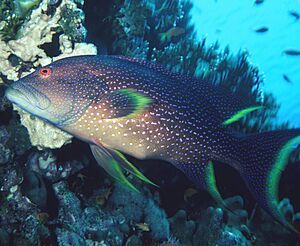Yellow-edged lyretail facts for kids
Quick facts for kids Yellow-edged lyretail |
|
|---|---|
 |
|
| Conservation status | |
| Scientific classification |
The yellow-edged lyretail (Variola louti) is a colorful fish found in the ocean. People also call it the yellowedge coronation trout, fairy cod, or moontail seabass. It's a type of grouper, which belongs to a family of fish called Serranidae. This family also includes sea basses. You can find this fish in the Indo-Pacific region, which covers a large area of the Indian and Pacific Oceans. It's quite common there.
Contents
What It Looks Like
The yellow-edged lyretail has a body that's longer than it is tall. Its head is also longer than its body is deep. The part of its head near the gills is rounded and has small, fine bumps. It has three flat spines on its gill cover.
This fish has two main fins on its back and belly. The top fin (dorsal fin) has 9 stiff spines and 13–14 soft rays. The bottom fin (anal fin) has 3 spines and 8 soft rays. Its tail fin is shaped like a crescent moon, with the top and bottom parts much longer than the middle.
The yellow-edged lyretail is usually reddish in color. It often fades to orange or white on its belly. It has many small bluish or pinkish spots all over its head, body, and fins. The edges of its fins are bright yellow. Young yellow-edged lyretails look a bit like goatfish. This fish can grow up to about 83 centimeters (33 inches) long, but 75 centimeters (30 inches) is more common. It can weigh up to 12 kilograms (26 pounds).
Where It Lives
The yellow-edged lyretail lives in the Indo-Pacific region. You can find it from the east coast of Africa, all the way to the Red Sea. It also lives across the tropical Indian Ocean and into the Pacific Ocean. Its range goes as far north as southern Japan and south to Australia. It can even be found as far east as the Pitcairn Islands.
In Australia, it lives from Shark Bay in Western Australia to Sydney in New South Wales. It's also found around many reefs and islands in the Coral Sea and Tasman Sea. Recently, this fish has been seen in the eastern Mediterranean Sea near Cyprus. This might be because some were released from aquariums, or they traveled there from the Red Sea through the Suez Canal.
Life and Habits
The yellow-edged lyretail usually lives in clear ocean waters. It prefers depths greater than 15 meters (50 feet) but less than 350 meters (1,150 feet). It likes to live around islands and reefs that are far from the coast.
This fish mostly eats other fish. It also enjoys crabs, shrimps, and small, shrimp-like creatures called stomatopods. Female yellow-edged lyretails are ready to have babies when they are about 33 centimeters (13 inches) long. They have been seen gathering in groups to lay eggs off Aceh in Sumatra. They usually lay their eggs between December and February. Scientists are still studying if these fish change their sex during their lives.
About Its Name
The yellow-edged lyretail was first officially described in 1775. A Swedish scientist named Peter Forsskål gave it the name Perca louti. He found it near Jeddah in Saudi Arabia and Al Luḩayyah in Yemen. Later, another scientist named William Swainson created a new group for it called Variola. The name Variola louti is now its official scientific name.
How People Use It
The yellow-edged lyretail is a popular fish to eat. However, sometimes eating it can make people sick. This sickness is called ciguatera poisoning. Because of this, selling fish heavier than 1.5 kilograms (3.3 pounds) is not allowed in Mauritius. The risk of poisoning also means it's not often caught or sold in Japan and some parts of Southeast Asia. You can also find this fish in home aquariums and in the live food fish trade.
Images for kids



